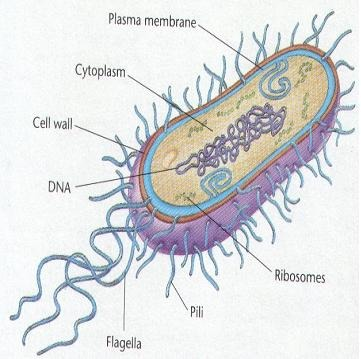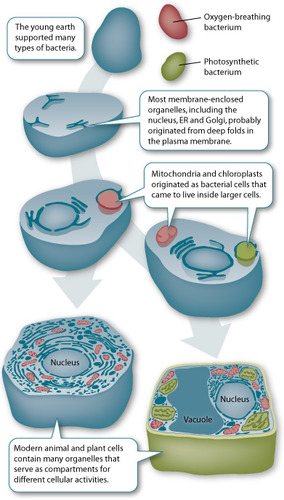1.1.1 Eukaryotic and Prokaryotic Cells
1/50
Earn XP
Name | Mastery | Learn | Test | Matching | Spaced |
|---|
No study sessions yet.
51 Terms
What is a eukaryotic cell?
Complex cells with a nucleus
True or false?
Prokaryotic cells have membrane-bound organelles.
False
True or false? Chloroplasts are found in all eukaryotic cells.
False
What is the role of chloroplasts in photosynthesis?
Convert light energy
What type of DNA do prokaryotic cells have?
Circular DNA
Which type of cell is found in plants, animals, fungi, and protists?
Eukaryotic
True or False?
Prokaryotic cells lack a membrane-bound nucleus.
True
Which organelle carries out photosynthesis in plant cells?
Chloroplasts
• What is the key difference between eukaryotic and prokaryotic cells?
Presence of a nucleus
• What is the function of mitochondria in eukaryotic cells?
Produce energy
• What is the simpler type of cell found in bacteria and archaea?
Prokaryotic
• Which organelle carries out photosynthesis in plant cells?
Chloroplasts
• What do vacuoles store in eukaryotic cells?
Materials and structure
True or false?
Prokaryotic cells have membrane-bound organelles.
False
True or false? Chloroplasts are found in all eukaryotic cells.
False
What is the role of chloroplasts in photosynthesis?
Convert light energy
What type of DNA do prokaryotic cells have?
Circular DNA
Which type of cell is found in plants, animals, fungi, and protists?
Eukaryotic
True or False?
Prokaryotic cells lack a membrane-bound nucleus.
True
Which organelle carries out photosynthesis in plant cells?
Chloroplasts
Prokaryotic cell
a cell that lacks a nucleus and other membrane bound organelles; includes archaea and bacteria

Eukaryotic Cell
a cell containing a nucleus and other membrane bound organelles
Endosymbiosis Theory
the idea that the mitochondria and chloroplasts were once free living and were engulfed by other prokaryotic cells.

Nucleus
a part of the cell containing DNA and RNA and responsible for growth and reproduction
Ribosomes
non membrane bounded organelles responsible for protein synthesis; found in eukaryotes and prokaryotes
Rough Endoplasmic Reticulum
System of internal membranes within the cytoplasm. Membranes are rough due to the presence of ribosomes. functions in transport of substances such as proteins within the cytoplasm
Smooth Endoplasmic Reticulum
An endomembrane system where lipids are synthesized, calcium levels are regulated, and toxic substances are broken down.
Golgi Apparatus
An organelle in eukaryotic cells consisting of stacks of flat membranous sacs that modify, store, and route products of the endoplasmic reticulum.
Lysosome
membrane-bound sac containing digestive enzymes that can break down proteins, nucleic acids, and polysaccharides
Central Vacuole
a large, fluid-filled organelle that stores not only water but also enzymes, metabolic wastes, and other materials; provides turgor pressure in plant cells
Chloroplast
organelle found in cells of plants and some other organisms that captures the energy from sunlight and converts it into chemical energy; contains DNA
Mitochondrion
in eukaryotic cells, the cell organelle that is surrounded by two membranes and that is the site of cellular respiration, which produces ATP; contains DNA
Cytoskeleton
network of protein filaments within some cells that helps the cell maintain its shape and is involved in many forms of cell movement
Cell wall
strong wall outside a plant cell's plasma membrane that protects the cell and maintains its shape
Cilia
short structures projecting from a cell and containing bundles of microtubules that move a cell through its surroundings or move fluid over the cell's surface
Flagella
A long cellular appendage specialised for locomotion, formed from a core of nine outer doublet microtubules and two inner single microtubules, ensheathed in an extension of plasma membrane.
Centrosome
small region of cytoplasm adjacent to the nucleus
Centrioles
One of two tiny structures located in the cytoplasm of animal cells near the nuclear envelope; play a role in cell division.
Cell membrane
a phospholipid layer that covers a cell's surface and acts as a barrier between the inside of a cell and the cell's environment
Domain Bacteria
prokaryotes do not have a nucleus, no membrane bound organelles,
Domain Archaea
prokaryotes do not have a nucleus , no membrane bound organelles
Domain Eukarya
eukaryotes have a nucleus and membrane bound organelles
Cytoplasm
A jellylike fluid inside the cell in which the organelles are suspended
Plasmid
a circular DNA molecule that is usually found in bacteria and that can replicate independent of the nucleoid DNA
Chromosome
threadlike structure within the nucleus containing the genetic information that is passed from one generation of cells to the next Prokaryotic cells do not have them.
• What is the key difference between eukaryotic and prokaryotic cells?
Presence of a nucleus
• What is the function of mitochondria in eukaryotic cells?
Produce energy
• What is the simpler type of cell found in bacteria and archaea?
Prokaryotic
• Which organelle carries out photosynthesis in plant cells?
Chloroplasts
What do vacuoles store in eukaryotic cells?
Materials and structure
What is a cell?
The smallest unit of life that can live on its own. Cells make up all living organisms and their tissues